Chairman Wheeler, tear down that wall!
What will it take for FCC to break the 95 GHz ceiling in the "Spectrum Frontier" NPRM?
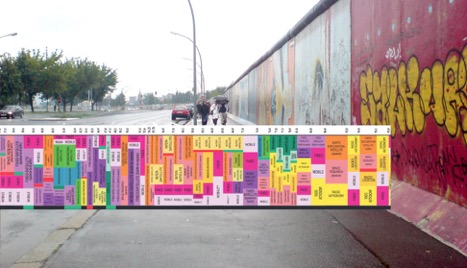
On October 16, 2003 in the Report and Order of Docket 02-146, FCC raised the upper limit of its radio service rules to 95 GHz. They have remained there ever since. The table below from the FCC Allocation Table, §2.106, shows the spectrum allocations and service rules from 86 to 105 GHz. Note the orange circle we have added to emphasize the lack of rules above 95. (Actually there are two small and narrow exceptions: amateur radio use and ISM use.)
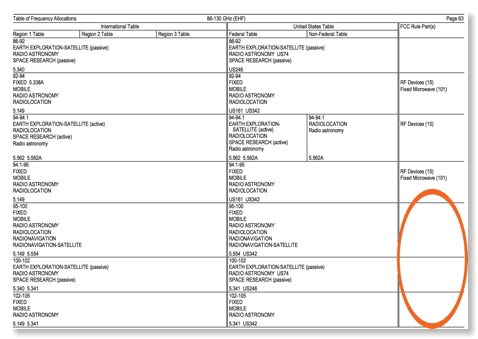
Chairman Wheeler last week announced "rebranding" the Docket 14-177 NOI in a "Spectrum Frontiers" NPRM that will be considered at the 10/22 Commission meeting. He stated:
This NPRM proposes a framework for flexible spectrum use rules for bands above 24 GHz, including for mobile broadband use. Promoting flexible, dynamic spectrum use has been the bedrock that has helped the United States become a world leader in wireless.
We are leveraging regulatory advances and propose to use market-based mechanisms that will allow licensees to provide any service – fixed, mobile, private, commercial, and satellite – depending on the band, and allow unlicensed uses to continue to expand. We are proposing to create a space that leverages the properties of this high band spectrum to simultaneously meet the needs of different users.
We hear from usually reliable sources that the NPRM will follow the NPRM and ignore the comments in keeping the bands considered under 95 GHz. In an August statement Chmn. Wheeler wrote
Our sources report nothing has changed. Furthermore despite the phrase "for a wide variety of users" the NPRM is expected to focus on the needs of CTIA members. We do not think it is inappropriate to provide new spectrum for such carriers, even though many are frankly ambivalent. (VZW did not even bother to file reply comments.) But what about other possible users?The spectrum bands proposed by the United States to be studied for consideration at WRC-19 include 27.5-29.5 GHz, 37-40.5 GHz, 47.2-50.2 GHz, 50.4-52.6 GHz, and 59.3-71 GHz. We will consider these bands, or a subset of the bands, in further detail in an upcoming NPRM, with the goal of maximum use of higher-frequency bands in the United States by a wide variety of providers.
What about broadband fixed links between locations where fiber installation is very expensive? (The fiber and electronics for fiber optic systems are inexpensive leading to a low cost/bit/mile if you exclude installation cost. But in urban environments installation costs can be huge for new fiber.) Millimeterwave fixed systems can serve such applications with a higher hardware cost, but lower total cost than fiber optics. Yet they face the same 95 GHz barrier!

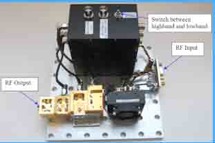
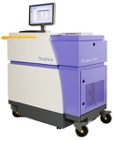
Why not also remove regulatory uncertainty from the manufacturers who are providing gray market equipment for non communications uses such as Terahertz spectroscopy? For example at left is a 575-560 GHz source sold by a US firm for THz spectroscopy and at the right is a Japanese system for use at 60 - 4000 GHz. These exist in a Title III "Never Never Land" with respect to their legality. Clearly they are not a target of the rapidly shrinking spectrum enforcement operation at FCC, but any investor doing due diligence would be thoroughly puzzled about the regulatory status of such technology. Such uncertainty is a disincentive to private capital formation which may explain why the more elegant device above comes from a Japanese firm.
In recent months ETSI, a nominal "standards organization" that includes most European counterparts of FCC, released the above report which is basically a master plan for millimeter wave development by Europe, Inc. while FCC stalls at 95 GHz. The applications considered in the ETSI report include both those of cellular carriers and other applications. They do not have tunnel vision focused solely on the needs of CTIA's European counterparts and spectrum below 71 GHz. (Does the Commission remember that in 1985 all the key industry players all opposed the Docket 81-413 rulemaking that is now the basis of both Wi-Fi and Bluetooth?)
Indeed, if FCC is at a loss what to do, maybe it should just propose endorsing the ETSI report? This would significantly reduce regulatory risk for US entrepreneurs!
Both the FCC's Asian and European counterparts, APT and CEPT, are proposing for WRC-15 new agenda items for WRC-19 that would go far beyond FCC's present technological meekness. APT proposes to "study potential candidate frequency bands for use of the land mobile and fixed services” between 275 GHz and 1000 GHz while CEPT proposes to “identify candidate frequency bands for use by systems in the land mobile and fixed services” in bands up to 450 GHz. FCC just can think beyond 95 GHz! Why?
Spectrum Policy and Wireless Innovation
From 2/15 issue of
It is often said these days that “technology moves at Internet speed”. One thing that differentiates wireless technology that is the subject of this publication from most other technologies in the field of interest of the IEEE global community is that it is regulated much more than other electrotechnologies. For example if one makes a breakthrough in semiconductor device technology or in computer display technology, one can develop the breakthrough in secrecy until it is time to market the technology. Such technologies need no a priori government approvals, except perhaps for routine approvals related to safety issues or unintentional RF emissions.
This point was made clear to the author in a 1981 article in IEEE Spectrum shortly after he started working on spectrum policy issues:
Pressed by a competitor who was selling (foreign) manufactured sewing machines for the home at lower cost, the Singer Sewing Products Group counter attacked. For four years, designers and development engineers worked in secret at the Singer headquarters in Elizabeth, NJ putting together a sewing machine that would, in one stroke, make existing machines on the market obsolete. What they were aiming for was the world's first electronic sewing machine. … The radical design would enable Singer to eliminate approximately 350 precision- made mechanical parts found in comparable machines on the market. … Success was instantaneous. The original marketing estimate of 300 machines per week jumped to 500 just prior … introduction. In less than a month after its introduction, the estimate was raised to 2000 machines per week.
The article even describes how Singer was able to ensure marketing surprise by using other divisions of the parent firm in the development and to purchase the needed parts to hide the interest of the sewing machine division. Is such market surprise possible in the wireless technology area?
The Apple iPhone is actually an example of “disruptive innovation” in wireless products that was able to achieve marketing surprise comparable to the Singer case. Apple was able to achieve this by an innovative combination of nonspectrum technology e.g. processing, display, and memory, with wireless physical layer technologies that were already approved and or the market. While the initial iPhone needed the routine approvals that Wi-Fi devices, Bluetooth devices, and ordinary cellphones require for inband powers, out-of-band emissions, and RF safety, these were routine approvals posing little risk and could be obtained at the last moment before marketing. No spectrum policy issues necessitated early disclosure of the iPhone’s innovative characteristics.
Unfortunately such marketing surprise is not possible for many wireless technology innovations. The basic pattern for spectrum policy was set after the sinking of the Titanic in 1912. At that time the highest frequency possible for commercial use was less than 1 MHz and radiotelegraphy was the only practical modulation. By 1934 when the US FCC was created, the highest frequency in routine use in the US was 2.5 MHz and its first annual report mentioned “possibility” of VHF use “above 30 megacycles”. In the modulation area, amplitude modulation was then a new alternative to radiotelegraphy.
Given these beginnings and the slow pace of technical innovation in the early days it made sense for the international and national regulators to specific uses for bands and allowed modulations and powers to control potential interference. ITU also adopted a definition of “harmful interference” that made sense with the technologies of the era, although it has some ambiguities with the case of newer technologies and bands with propagation characteristics not anticipated when the definition was drafted .
The ITU has tried to become more reactive by having more frequent world radio conference, for example the 3½ year time gap between WRC-12 and WRC-15. National regulators have tried to minimize regulatory delays of new wireless technologies by increasing the focus of regulations from prescriptive use of specific technology to increasing the focus of regulations to preventing interference to other users. However, this is difficult to do with a regulatory legacy this is a century old as regulators are governmental bodies that do not move at “Internet speed”, but rather time constants that are associated with due process issues according to the form of government in each country. In addition, in some parts of the world there are regional bodies such as CEPT’s European Communications Committee and the European Commission’s Radio Spectrum Policy Group that have a supernational role in spectrum policy.
This is the 150th anniversary of the initial publication of James Clerk Maxwell’s electromagnetic theory that is summarized in the ubiquitous – at least among the readers of this publication – Maxwell’s Equations. It is important to remember that spectrum policy issues are just as important and just as real for new wireless technologies as Maxwell’s Equations are if you are interested in practical actual use of the technologies as opposed to just publishing a theoretical article in a prestigious IEEE publication. However, there is a key difference: Maxwell’s Equations present key physical limits, for example, information can not be transmitter faster than the speed of light. While the constraints of spectrum policy are just as real, they are not physical limits and they evolve just as all governmental policies around the world evolve with time. Thus it is important for wireless technology innovators to be familiar with both current spectrum regulations as well as the national and international processes involved with modifying them to deal with innovative technologies in both current bands and bands that are not presently used.
While many evolving technologies face regulatory dilemmas with respect to their timely implementation in practical use, early identification of such issues in the research and development cycle can lead to early engagement in the spectrum policy arena to minimize delays due to policies that were developed in a different era and which may have become anachronistic.
French Prime Minister Georges Clemenceau famously said “war is too important to be left to generals”. For the wireless technology community, spectrum policy is too important to be left to regulatory specialists. Readers can help themselves and help the whole wireless technology community by understanding national and international spectrum policy issues related to their research and engaging in deliberations in their own country, including national inputs to ITU-R activities.
New Technologies for Wi-Fi
The unlicensed crowed has not been sitting on its hands while all this new technology has been developed on the cellular side. IEEE Communications magazine in its November 2014 issue has a focus on the “The Future of Wi-Fi”.
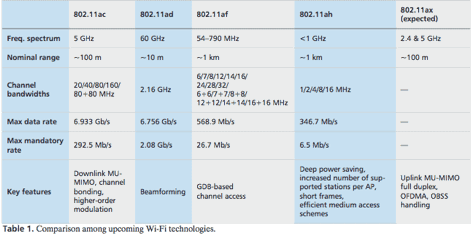
Above is a table from one of the Wi-Fi articles that gives some future versions of Wi-Fi along with their expected technical features.
These 4 papers give an overview of the new technologies that are expected to be implemented in licensed and unlicensed wireless communications in the next few years. The wireless mic gang might want to look at these technologies and ask why they are still obsessed with 1930s-based wideband FM. But other spectrum users, including federal users regulated by NTIA, might want to view these as a data point they should be judged by.
Field of Dreams & Spectrum Policy
This week, the 80th anniversary of the Communications Act of 1934, is also the 25th anniversary of “Field of Dreams”, the movie most remembered for the line “If you build it … they will come”. While I recall that President Bush (41) publicly said he was confused about the movie, President Bush (43) actually was a great fan.
The connection to spectrum policy? Classic FCC spectrum policy (along with spectrum policy in other places) was prescriptive - that is users could do A and B, but not C if C was not explicitly allowed. Thus when I joined FCC in 1979, land mobile (Part 90) users were allowed AM and FM modulation and it took a long series of rule makings, some of which inconsistent in their final technical details details, to allow digital modulation for all users. By contrast, today’s rules are generally (broadcasting and public safety being major exceptions) proscriptive in that they tell you what you may not do - generally things that would result in interference to other users.
The reason why the 1981-85 rulemaking that brought forth Wi-Fi, Bluetooth, ZigBee and many other less known products was so controversial that it resulted in an attempt to fire your blogger after the rules were adopted was that it was an earlier action to move away from this prescriptive model. The rules adopted in Docket 81-413, now updated and codified as 15.247, did not say “let there be Wi-Fi”, they said “here is this spectrum, here are rules that prevent harm to anyone else, feel free to innovate and offer new products to the public and let’s see where this goes! “ (In truth, in 1985 wired/Ethernet LANs were nonexistent in offices and homes and there are no interest in any type of wireless LAN as a product for serial production. But the flexibility grand in the Docket 81-413 R&O meant that when interest developed for RLANs within a few years those interested did not have to come to FCC and grovel for permission for years. Thus they had timely market access and history was made!)
So as we near the 1 year anniversary of the IEEE-USA petition for FCC on the spectrum above 95 GHz that now lacks any rules (and is hence implicitly forbidden for normal licensed or unlicensed use) today let us ponder what we gain by having no such rules or even a defined path to such rules. In the Docket 81-413 rulemaking most commenters were opposed saying the technology under discussion was “blue sky” and had no demand. Yet within 2 years commercial products were available. A few years later came Wi-Fi and Bluetooth -- now “applications that have changed our world”.
Let us ponder of the lessons of “If you build it … they will come” and also the spectrum policy variant: “If you allow it .. they may well build it”. Let’s see if we can convert most FCC spectrum rules from prescriptive to proscriptive structure. (The cellular rules generally have this approach already.)
ABC US News | ABC Celebrity News
CTIA and NAB's Battling Innovation Websites - I
The blood feud between CTIA and NAB is being expressed now in battling websites, each claiming how innovative their side is. From NAB we have WeAreBroadcasters.com/Innovating and from CTIA we have WirelessisLimitless.org. This is the first of a 2 blog series examining these claims. To be “fair and balanced”, as Fox News would say, we will deal with both sites. CTIA was randomly selected to be first. The following 2 videos are at the top of the CTIA site.
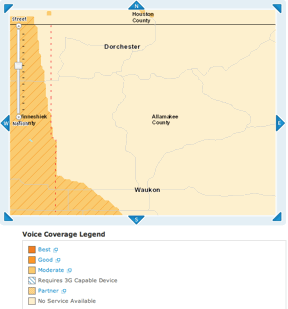
Agriculture is important to the economic fabric of Allamakee County and Iowa. Allamakee County’s 1,032 farms cover 274,844 acres of land, which accounts for 65 percent of the surface land in the county. Crop and livestock production are the visible parts of the agricultural economy, but many related businesses contribute as well by producing, processing and marketing farm and food products. These businesses generate income, employment and economic activity throughout the region.Allamakee County farmers harvested 60,364 acres of corn and 22,008 acres of soybeans, and produced 87,017 hogs and 55,246 head of cattle in 2007. Farms on average are smaller in Allamakee County, at 266 acres, than the statewide average of 311 acres. Sales per farm in Allamakee County were $127,524 in 2007.
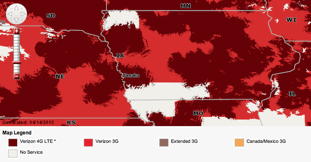
Now is spectrum shortage the reason for this lack of cell coverage in these farming areas? A check of the FCC Spectrum Dashboard shows that VZW (dba Cellco Partnership) has licenses in : Fremont, Page, Taylor, Ringold, and Decatur counties in both 700 MHz and the 1700/2100 MHz band, while AT&T (dba AT&T Mobility Spectrum LLC) has licenses in the same 2 bands in Allamakee County where it has no service.
Another odd thing about the videos is the focus in the first one on Smartfield, Inc.’s SmartCrop field monitoring technology. Quite impressive. So we surfed over to the FCC’s equipment authorization site to learn more about this equipment. (Smartfield’s grantee code is “W9B” if you want to check.) Smartfield has 7 FCC equipment authorizations, all of which are for unlicensed Part 15 equipment, the type of thing that CTIA consistently opposes new spectrum for. The video claims that the SmartCrop system uses cellular paths for transmission of data from a central point in the field to Smartfield’s analysis service. So the SmartCrop system appears to be a hybrid unlicensed/cellular service - an inconvenient fact not mentioned in the video.
The second video focus on the wonders of John Deere’s high tech services for farmers. Remember John Deere? These are the people with the irresponsible GPS receiver front end design that covered the GPS band as well as the band above and below it even though it was public knowledge that LightSquared and its predecessors had been given authority to build base stations in the lower band years earlier. The Deere GPS design was easily overloaded by any nearby signal in the adjacent bands and thus was a major cause for the current interest in receiver standards. The CTIA membership did not want LightSquared to compete with them and probably encouraged the John Deere issue as the poster child in the anti-LightSquared campaign to garner political support from farm state members of Congress. So maybe this focus on John Deere could be payback for their anti-LightSquared help.
But if you are a farmer and want to use technology like Smartfield’s or John Deere’s, you really have to have cellular service and the main CTIA members don’t seem to be in a rush to use their existing spectrum to give it to you as they demand more spectrum.
As a sailboat owner, your blogger was impressed with the beauty of the photography in this CTIA video on the Wireless is Limitless site:
Your blogger’s cellular booster antenna
Carrier registration pending
(vertical white rod)
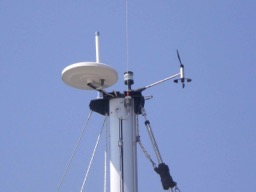
This video describes how the Chesapeake Bay Interpretive Buoy System uses cellular transmission to get real time data on water conditions to fishermen (actually called “watermen” in local parlance) and researchers. But then we recalled that the reason we have a “cellular booster” (fought against so long by the cellular industry in Docket 10-4 and the CTIA 2007 petition) on our boat is that cellular coverage on Chesapeake Bay has real problems. (A cellular industry spectrum specialist acquaintance who also sails - but will not be named here - uses Iridium to keep in touch from his boat.) Let’s look at VZW’s claimed coverage (AT&T’s and T-Mo’s are similar) on Central Chesapeake Bay, the area near Solomons, MD actually shown in the video:
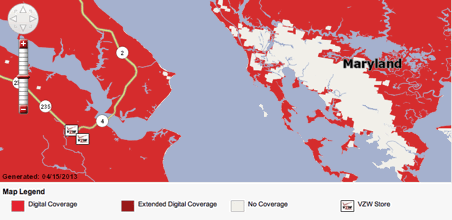
Guess what FCC’s Spectrum Dashboard shows here? Yup, AT&T, T-Mo, and VZW all have multiple licenses in Dorchester County where the white blocks are on all their coverage maps. This is also not a mountainous area.
So whether it is farming in Iowa or maritime coverage on Chesapeake Bay, there are real cellular coverage problems that have nothing to do with spectrum presently available to the cellular industry. As shown above, in these nonmontainous areas there seems to be a lack of interest in the major cellular carriers to finish rolling out their networks. This is good for Iridium and other satellite carriers, but not really good for the public.
The cellular industry certainly needs more spectrum access to keep up with expanding uses that help our society and the economy. But these rural cases are good examples of why spectrum sharing is so important. The real spectrum shortage is in urban areas where civil demand is great and military use small - San Diego being a notable exception. But the demands of the industry for complete reallocations when they can’t even use all the spectrum they have today sound hollow. Why can’t all spectrum users work together to find mutually beneficial solutions to their spectrum problems that don’t depend on cheap Chinese-made equipment. Let’s cool the PR rhetoric and work on real problems.
The review of NAB’s site, also over the top, with be up in a few days.
Retrospective Analysis at the FCC
The title of this post was also the title of a 8/9/11 post by Ruth Milkman on the FCC’s own blog. It describes FCC implementation of a 7/11/11 Executive Order entitle “Regulation and Independent Regulatory Agencies” -- which it oddly did not give a link to it or even its EO number - 13579, as shown above. (See, SpectrumTalk is nicer to its readers than FCC’s blog!)
The core of EO is the following:
To facilitate the periodic review of existing significant regulations, independent regulatory agencies should consider how best to promote retrospective analysis of rules that may be outmoded, ineffective, insufficient, or excessively burdensome, and to modify, streamline, expand, or repeal them in accordance with what has been learned. Such retrospective analyses, including supporting data and evaluations, should be released online whenever possible.
This policy is similar to the Carter Administration’s Executive Order 12044 that I have previously written about here and that was the initial impetus to what became Wi-Fi and Bluetooth. Regulation of a dynamic technology such as wireless technology is bound to become anachronistic and need updating. This need for updating in turn leads to delays for new technology and discourages capital formation for new technology. As Mitch Lazarus has written in comments in the “Wireless Innovation NOI” (which has seen no Commission action in over 2 years!),
Often a radically new technology comes from a small, privately-funded start-up. Its only product may be the one awaiting Commission approval. These companies may lack the resources to survive a lengthy FCC proceeding.
Several FCC sua sponte deregulatory spectrum initiatives that I initiated have resulted in product development that has stimulated economic growth. Such initiatives are not popular with industry insiders and conservative FCC staffers who prefer focus on the the spectrum analog of “no one ever got fired for buying IBM”. Here are some specific initiatives and their impact:
- Docket 81-413 - Wi-Fi, Bluetooth, and ZigBee
- Docket 83-114 - via successor Docket 85-171 resulted in technical deregulation for Part 90 modulation and bandwidth
- Docket 94-124 - 60 GHz products such as 802.11ad
- Docket 96-35 - permitted flat microwave antennas implicitly forbidden by previous rules
- Docket 02-146 - commercialization of 70/80 GHz bands
Ms. Milkman writes in the FCC blog,
The President's directives are consistent with the values and philosophy we apply here at the FCC. In a press conference following the release of the July 11 Executive Order, Cass Sunstein, the head of the Office of Information and Regulatory Affairs in OMB, noted that the FCC has a robust regulatory review process in place. Under Chairman Genachowski's leadership, we are proud of the progress we have made so far.
I do not disagree with much of what she writes, however, there are real limitations to the 47 USC 161 biennial review process that I think she was referring to. The statute refers to review of “all regulations issued under this chapter in effect at the time of the review that apply to the operations or activities of any provider of telecommunications service”. In the past, the Commission has interpreted Section 161 in the narrowest possible sense to limit its work. Indeed, I recall during the Powell chairmanship numerous efforts were made by upper commission leadership to limit the scope of biennial review and keep it as narrow as possible so it would not be a distraction to the current agenda.
For example, I filed comments in the 2008 review. Perhaps these were brilliant comments, perhaps not. What happened to these comments? Well, in July 2010 when the results of the biennial review were released - a time during the Genachowski chairmanship - FCC dismissed the comments based on a narrow interpretation of the statute stating,
" the comments did not suggest that the rules should be repealed or modified because they are no longer in the public interest as the result of meaningful economic competition between telecommunications service providers. Accordingly, OET concluded that these comments were beyond the scope of the section 11(a) review".
Thus a narrow interpretation of Section 11(a)/47 USC 161(a) was seen as a preferred alternative to considering the merits of the suggestion!
This I have submitted to the FCC blog a comment stating that if they are serious about “retrospective analysis” they could start by looking at ALL the biennial review proposals in recent years that were dismissed for such bureaucratic reasons and consider them on their merits - not narrow interpretations of Section 11! But while we at at it, how about some action on the Wireless Innovation NOI (09-157)?
Deficit Limits, Budgets and Their Likely Impact on Wireless Innovation at FCC
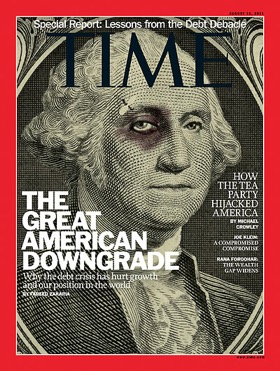
In the 1970’s FCC went twice to the National Academies to ask for policy research studies on major technical controversies that were delaying industry growth. These two studies then became the frameworks of Part 25 Fixed Service/domsat sharing in C band and the Part 68 interconnection rules that opened the floodgates for CPE - units connected to the telephone line.
However, the early Reagan cutback eliminated funding for such studies and slashed technical staffing at FCC. The 8th Floor grew increasingly interested in universal service issues, broadcast ownership and content, and, more recently, in broadband issues. These are all important issues, but so are the technical issue of spectrum policy particularly as they relate to wireless innovation. While is is tempting to see broadband on in terms of repurposing spectrum to me some goal, the needed capacity is a function of spectrum, technology, and infrastructure investment - as was made clear in a recent Ofcom report.
New technology does not emerge spontaneously. Wireless technology is subject to unusual regulatory issues and the complex nature of this and resulting uncertainties is a real discouragement to wireless innovation - something acknowledged by FCC in the Wireless Innovation NOI.
The present spectrum “haves” may well prefer less FCC action in encouraging and considering new wireless technology and thus may be cheering secretly for pending cutbacks in technical policy resources at FCC. But the national interest is not always the interest of the major corporations roaming the halls of the 8th Floor. We all recall when Microsoft, Google, Apple, and RIM where small firms getting little attention among the established firms such as Motorola, RCA, GE, IBM, etc.
The excess time delays associated with many recent decisions in wireless policy, either big decisions like the AWS-3 nondecision after 4 years of deliberations and the similar delays in delays and nondecisions in much less controversial matters ably described by Mitch Lazarus in comments to the Commission, both delay new technology and discourage investment in it vis-a-vis other fields with more transparent regulation.
The 1980s shrinkage in FCC resources was repeated again in the last half of the last decade:
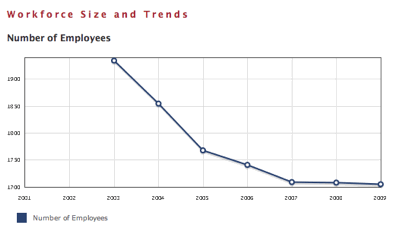 \
\
FCC staffing 2003-1009 (http://bestplacestowork.org/BPTW/rankings/detail/FC00)
Sadly, it is virtually inevitable that the current budget/debt limit mess will lead to the same resource devastation. Much of the FCC constituency, like much of the EPA and SEC “constituencies”, would prefer that their regulatory agencies be cut to allow the “market” to be more effective. Indeed, Indiana Gov. Mitch Daniels calls EPA the “employment prevention agency”. Perhaps it is, but in many of its decisions FCC is the employment creation agency! A one size fits all slashing of agency budgets will adversely affect wireless innovation even if it spares the narrow issue of finding more spectrum for broadband.
NAB and MSTV might view a freeze of all present FCC regulations as being in their interest. CTIA and CEA might want a singleminded focus on more spectrum for broadband and ignoring all other spectrum issues. Indeed, by focusing exclusively on “clearing spectrum” for broadband the impact of broadband on other incumbents will be worse since new technology for either broadband applications or other incumbents, e.g. broadcaster, will be put on hold unless they are lucky enough to be already allowed under today’s anachronistic rules. Capital formation for innovative wireless technology will dry up nearly completely since there will be unpredictable delays in getting FCC action on necessary rule changes/interpretations. Under such circumstances FCC could truly become the “employment prevention agency” agency and wireless innovation would be reduced to making overseas standard making organizations like ETSI the gatekeeper to US spectrum - US startups need not apply without huge capital resources and foreign partners.
If FCC can not get a reprieve from the pending budget ax, let me point out a less desirable alternative that has not been discussed: Making new technology deliberations user fee supported. Note that this is already allowed at FDA for new drug and new device applications, at USPTO for speeding patent applications, and at USNRC for speeding reviews of new reactor technology.
FCC could ask for authority to collect fees for dealing with new technologies that raise interference questions and then use those fees to speed up deliberations by using outside resources to supplement its staff or hire more staff. In exchange for this income, FCC would have to pledge timeliness improvement from its present poor performance in new wireless technology deliberations. This might be done by asking that Section 7 be amended to make it realistic, not an unobtainable goal as at present. While this would make wireless innovation more costly by internalizing the cost of FCC deliberations into a business plan, it may well be more attractive to wireless R&D investor than the present chaos.
But FCC deliberation on innovative wireless technology consistently violate Section 7 under current funding and the expected funding contraction will only make it much worse. Innovators do not expect regulator certainty, but do expect and deserve transparency and timely resolution.
Can Cognitive Radio Technology Help Solve Some Difficult Spectrum Management Issues by Creating "Virtual Guardbands"?

The hidden node problem refers to the problem of protecting receivers from interference in a cognitive radio system when you can’t explicitly detect the receiver’s presence. This is the crux of the TV whitespace problem since TV receivers can not announce their presence. (In that case the use of cognitive radio detectors 20+ dB more sensitive than TV receivers can be used to solve the problem although FCC chose the more conservative approach of geolocation for initial implementation.)
The instant article considers the case of a full duplex mobile transmitter with known frequency offset, as in the case of the ubiquitous cellphone. It points out that in this case the hidden node is no longer “hidden” since it can be readily detected at short distances by the uplink signal and that the receiver frequency can also be calculated by adding the offset to the detected uplink frequency.
This is a special case of Preston Marshall’s general observation that while cognitive radios are best known for finding empty spectrum that can be used without cochannel interference, if you know the location and characteristics of nearby receivers you can also select frequencies that will not result in interference from adjacent channel or intermodulation mechanisms in receivers with limited rejection capability. Pres points out that receiver ejection capability is generally expensive because it requires on precise analog components, whereas cognitive radio technology is mostly digital with little marginal cost in the long run.
In the AWS-3 proceeding, T-Mobile, the adjacent channel licensee in most places, claimed that adjacent channel interference to their FDD downlink was inevitable if the adjacent AWS-3 were used for either uplinks or TDD. Since we now know that T-Mobile was “on the auction block” during this deliberation, they had every incentive to maximize their sale value by using a massive legal effort for both trying to stop a new entrant and removing any risk of interference from concerns of potential purchasers. One of the parties in the AWS-3 proceeding mentioned a variant of virtual guardbands in comments, but this was promptly dismissed by the cellular mainstream as speculative.
But while there might be some slight question of how well TV whitespace devices can detect a TV signal from 50 miles away that provides marginal reception to TV sets using antennas near the devices, detecting a cellphone uplink signal nearby - the only place where adjacent channel or intermodulation interference is a threat - is trivial by comparison.
Industry loves to demand guardbands: it is a proven technology to prevent interference and also limits competition. But guardbands also have a real cost in our spectrum dependent economy that is always searching for more spectrum. Virtual guardbands can be a realistic way to use today’s technology to avoid interference while allowing more intense spectrum use at the boundaries of FDD bands.
FCC has never resolved the AWS-3 issue, they just told M2Z Networks that no answer was coming soon. AWS-3 continues to lie fallow as we beat the bushes to find the 500 MHz of new spectrum demanded by the National Broadband Plan. - there are no easy answers. Maybe with technologies such as virtual guardbands we can put AWS-3 to use serving society and the economy. With AT&T and T-Mobile now before the Commission begging for permission to merge, maybe they can more more flexible on the AWS-3 issue as a merger condition.
Wireless Innovation and Interference
The Unfinished Radio Revolution:
New Approaches to Handling Wireless Interference
cosponsored by Silicon-Flatirons, IEEE-USA, CTIA, New America Foundation, and FCBA.
Innovative wireless communications is important not just for wireless operators and manufacturers, but also for firms in other industries that depend on the latest technology for improving their productivity and for new non-telecom firms such as Amazon, E-bay, Netflix that are enabled by cutting edge technology. It is key to the health of the US economy.
Most other industrialized nations use a state capitalism form of spectrum management and wireless industrial policy that uses Soviet-style economic planning
In contrast, since late 1970s FCC spectrum policy has focused on technical deregulation and market forces to stimulate innovation and growth. This year is the 25th anniversary of both Qualcomm’s founding and the regulatory basis for Wi-Fi and Bluetooth – all products of this deregulatory ferment.
Spectrum deregulation has a core goal of interference prevention:
- Assuring incumbents of realistic expectations so as to stimulate their investment AND
- Assuring innovators and entrepreneurs a transparent and timely red light/green light system for determining if innovative systems will cause “harmful interference”
FCC got it right in the Wireless Innovation NOI when it said
The viability of spectrum access for new radio services often centers on whether the new service may cause harmful interference to incumbent services. This can lead to delays through protracted rule making proceedings that can create uncertainty and discourage investment.
In the Northpoint/MVDDS, UWB, and AWS-3 proceedings we saw deliberations of harmful interference that not only violated the timeliness requirement of Section 7 of the Act but were totally inconsistent with any plausible business plan of a startup entrepreneur. Today’s capital markets make investments for such innovative technology almost impossible due to the excessive regulatory risk resulting from FCC’s slow deliberations.
Qualcomm got its key regulatory decision for CDMA 2 years after its founding. Such decisiveness in innovative spectrum policy is impossible today
Spectrum policy determination by fiscal exsanguination of entrepreneurs is both ineffective and inconsistent with our form of government.
If we can’t get spectrum deregulation and interference policy correct, the USA might be better off just joining CEPT and taking an active role in their spectrum management system - based on Soviet style economic planning.
Basic technical Issues in defining radio rights or interference
Receiver Standards
Explicitly stated expectations for adjacent channel rejection and intermodulation vulnerability, e.g. 3rd order intercept point, are urgently needed for each radio service in order to resolve harmful interference issues in a timely way. These standards should not be mandatory - which is just as well since FCC in general does not have such jurisdiction at present.
I/S Protection at Receiver
Made simpler by digital convergence. In most cases I/S of - 6 to -10 db is adequate, former mixed analog environment was more complex. However, CDMA systems have more complex concerns since interference translates into capacity. But environment noise levels set a natural baseline
I/S Field Strength at the Antenna vice I/S Power at the Receiver
MIMO technology is increasingly practical so in many cases some rejection by antennas should be considered
Propagation Models
Much of the controversy over TV white space results from the use of a 1966 precomputer age propagation model that FCC itself has said has severe limitations in its applicability. While propagation is an esoteric field, inappropriate models can warp any spectrum rights regime
MCL vice Stochastic Modeling
Incumbents prefer that the worst case MCL (minimum coupling loss) scenario is decisional. While FCC has a limited record of using stochastic modeling , both FCC and NTIA have no clear policy in this key area. However, in Europe, stochastic modeling is often used
Acceptable Interference Statistics
How much interference is acceptable? In the MVDDS decision FCC used naturally occurring rain outages as a baseline and decided to accept a 10% theoretical increase – something not noticeable in practice. FCC and NTIA should consider the general issue that naturally occurring outages in space and time should be considered as a reference point although the allowed increased should be determined on a case by case basis
Who should make detailed spectrum rights proposal for public consideration?
It is key that FCC and NTIA work in parallel here to develop consistent policies
Doubtful that present FCC or NTIA can develop a level playing field interference protection scheme that deals with both incumbents and new entrants fairly
In the 1970s, FCC - like other federal regulatory agencies with key long term technical policy dilemmas - asked National Academy of Sciences/National Research Council to propose regulatory framework for what later became Parts 25 and 68 – at the time exceedingly controversial issues opposed by powerful interests. The resulting C band terrestrial/satellite sharing and telephone interconnection resulted in tremendous economic growth and were emulated all over the world.
FCC and NTIA should consider asking NAS/NRC to repeat its past role – and the role it regularly plays for other agencies – to draft a specific framework for determining interference rights that balances all interests. It will never be an objective definition, but a framework that speeds up the present process will increase certainty for BOTH incumbents and innovators.
Your blogger’s detailed paper on this topic
IEEE-USA Writes to FCC & NTIA on Clarifying Harmful Interference
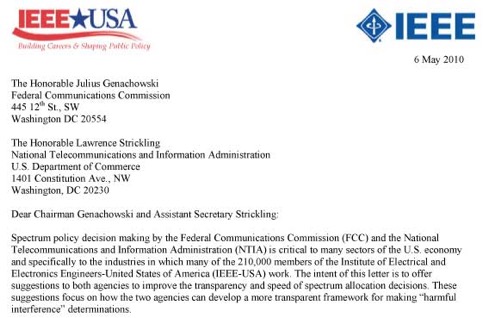
Yesterday, IEEE-USA sent a letter to both FCC and NTIA urging them to work together in clarifying the present definition of “harmful interference”. IEEE-USA is part of the IEEE, the world's largest technical professional society with over 395,000 members in over 160 countries and advances the public good and promotes the careers and public policy interests of more than 210,000 engineers, scientists and allied professionals who are U.S. members of the IEEE. (The above copy of the first paragraph is a link to the whole 4 page document.)
“Harmful interference”/HI is the traditional criterion FCC has used for determining whether interference from anew service to an incumbent service will be tolerable. It is also used 5 times in the Communications Act in a similar way. However, the definition is a 30 word sentence from the ITU Radio Regulations that is ambiguous in many situations. Thus HI determinations have been often been lengthly and expensive to participate in. For example, the Commission has been deliberating more than 4 years on whether TDD use of the AWS-3 band would cause HI to the lower adjacent 3G downlink band.
We have written previously about both the difficultly of defining HI and its importance after the Spectrum Inventory for identifying new spectrum that can be used without causing HI to incumbents. While an unambiguous definition of HI is impractical, any clarification and simplification for the process for making an HI determination will greatly speed up the availability of spectrum for new services and thus speed technical innovation.
Some quotes from the letter:
Uncertainties like this discourage capital formation for new radio technologies. Such uncertainties also affect capital formation for incumbents in determining how much protection they are entitled to from later entrants.
...
ITU-R M.1635 states that “Parts of the assessment procedures need to be based on a statistical methodology, well known as the Monte Carlo technique.” The UK’s national spectrum manager, Ofcom, has also advocated and frequently used statistical technique in spectrum policy decisions.2 Statistical techniques have been used by both FCC and NTIA in authorizing point-to-point fixed links where weather-related propagation losses are time variable3, and by FCC in authorizing broadcast stations because the Grade B contours include a statistical factor.
FCC and NTIA do not have a general policy on the use of statistical techniques in interference prediction even though many of the most contentious issues in recent years have focused on such issues. But no general guidance exists on how to extrapolate to cases involving other propagation phenomenon or mobile stations. Your agencies are in a position to begin to create such guidance.
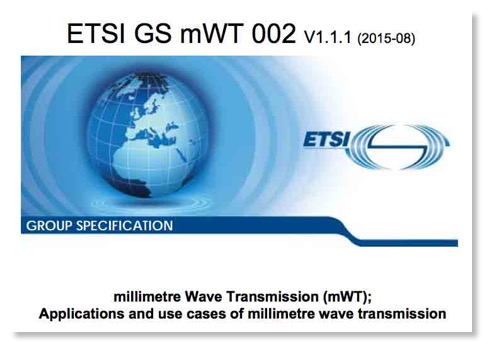
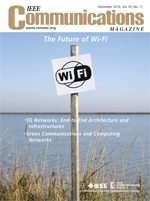
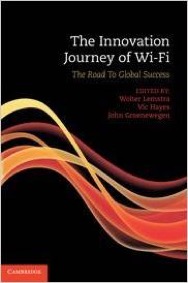
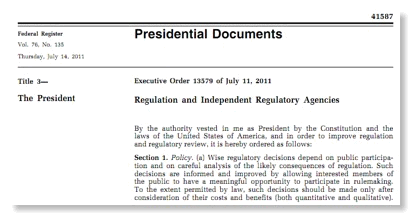



![Validate my RSS feed [Valid RSS]](valid-rss-rogers.png)

